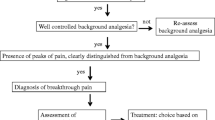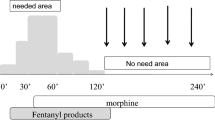Abstract
Breakthrough pain is a well recognized but ill-defined phenomenon that occurs commonly in the presence of otherwise stable, persistent pain. It is defined now as a “transient pain episode that occurs, or breaks through from the otherwise stable background pain.” Breakthrough pain is usually associated with moderate to severe pain and may form a predictor of poor response to treatment with routine pharmacotherapy. Breakthrough pain is also associated with functional impairment and psychological distress.
The assessment and treatment should be multidimensional. Although primary therapies such as chemotherapy, radiation treatment, and surgical options are explored, the mainstay of treatment is pharmacotherapy. Nonpharmacologic methods, such as orthotic devices and joint stabilizations along with behavioral methods, should be explored. Anesthetic and neurosurgical procedures are performed on a limited number of patients based on the prognosis, intractable nature of pain, and favorable risk/benefit ratio. Newer oral transmucosal fentanyl offers a favorable pharmacokinetic and pharmacodynamic profile and ease of administration.
Similar content being viewed by others
References and Recommended Reading
Portenoy RK, Hagen NA: Breakthrough pain: definition, prevalence, and characteristics. Pain 1990, 41:273–281.
Streisand JB, Varvel J, Stanski D, et al.: Absorption and bioavailability of oral transmucosal fentanyl citrate. Anesthesiology 1991, 75:223–229.
Bruera E, MacMillan K, Hanson J, et al.: The Edmonton staging system for cancer pain: preliminary report. Pain 1989, 37:203–209.
Bruera E, Schoeller T, Wenk R, et al.: A prospective multi-center assessment of the Edmonton staging system for cancer pain. J Pain Symptom Manage 1995, 10:348–355.
Kerr I, Sone M, DeAngelis C, et al.: Continuous narcotic infusion with patient-controlled analgesia for chronic cancer pain in outpatients. Ann Intern Med 1988, 108:554–557.
Bruera E, Fainsinger R, Mac Eachern T, et al.: The use of methylphenidate in patients with incident cancer pain receiving regular opioids. A preliminary report. Pain 1992, 50:75–77.
Mercadante S, Maddaloni S, Rocella S, et al.: Predictive factors in advanced cancer pain treated only by analgesics. Pain 1992, 50:151–155.
Mercadante S, Armata M, Salvaggio L: Pain characteristics of advanced lung cancer patients referred to a palliative care service. Pain 1994, 59:141–145.
Portenoy RK, Payne D, Jacobsen P: Breakthrough pain: characteristics and impact in patients with cancer pain. Pain 1999, 81:129–134. A cross-sectional study looking at the characteristics and the impact of breakthrough pain on function and psychological aspects. This study, therefore, signifies the importance of multidimensional assessment and management of breakthrough cancer pain.
Patt R, Ellison N: Breakthrough pain in cancer patients: characteristics, prevalence, and treatment. Oncology 1998, 12:1035–1046.
Simmonds M: Management of breakthrough pain due to cancer. Oncology 1999, 13:1103–1114. Covers all the aspects of breakthrough cancer pain. This article is followed by commentary by the other authors. But it fails to cover the importance of anesthetic and neurosurgical interventions in the management of breakthrough cancer pain. However, it is well referenced and the addition of commentaries provides a very critical review and well compensates the assessments and some of the treatment aspects of breakthrough pain.
Calava JM, Patt RP, Reddy S, et al.: Psoas sheath chemical neurolysis for management of intractable leg pain from metastatic liposarcoma. Clin J Pain 1996, 12:69–75.
Patt RP, Payne R, Farhat G, Reddy S: Subarachnoid block in a three-year-old child. Clin J Pain 1995, 11:143–146.
Rosomoff HL, Carroll F, Brown J, et al.: Percutaneous radiofrequency cervical cordotomy: technique. J Neurosurg 1965, 23:639–644.
Tasker RR: Percutaneous cordotomy: the lateral high cervical technique. In Operative Neurosurgical Techniques, edn 2. Edited by Schmidek HH, Sweet WH. Orlando: Grune & Stratton; 1988:1137.
Jacox A, Carr DB, Payne R, et al.: Management of cancer pain. Clinical practice guideline no. 9. AHCPR publication no. 94-0592. Rockville, MD: Agency for Health Care Policy and Research. US Department of Health and Human Services, Public Health Service; 1994.
Portenoy RK, Foley KM, Inturissi C: The nature of opioid responsiveness and its implications for neuropathic pain: new hypothesis derived from studies of opioid infusions. Pain 1990, 43:273–286.
Ettinger AB, Portenoy RK: The use of corticosteroids in the treatment of symptoms associated with cancer. J Pain Symptom Manage 1998, 3:99–103.
Pereira J, Mancini I, Walker P: The role of bisphosphonates in malignant bone pain: a review. J Palliat Care 1998, 14:25–35.
De Conno F, Ripamonti C, Saita L, et al.: Role of rectal route in treating cancer pain: a randomized crossover clinical trial of oral versus rectal morphine administration in opioid-naïve cancer patients with pain. J Clin Oncol 1995, 13:1004–1008.
Bruera E: The Simmonds article review: management of breakthrough pain due to cancer. Oncology 1999, 13:1103–1114.
Streissand J, Varvel J, Stanski D, et al.: Absorption and bioavailability of oral transmucosal fentanyl citrate. Anesthesiology 1991, 75:223–229.
Farrar JT, Cleary J, Rauck R, et al.: Oral transmucosal fentanyl citrate: randomized, double blind, placebo-controlled trial for treatment of breakthrough pain in cancer patients. J Natl Cancer Inst 1998, 90:611–616.
Christie J, Simmonds M, Patt R, et al.: Dose-titration, multicenter study of oral transmucosal fentanyl citrate for the treatment of breakthrough pain in cancer patients using transdermal fentanyl for persistent pain. J Clin Oncol 1998, 16:3238–3245. This article is aimed at providing the use of OTFC for the management of breakthrough cancer pain. It is well designed, randomized, double-blind, and placebo-controlled. This is one of the many articles on OTFC signifying the introduction of a novel route of opioid medications for the treatment of breakthrough cancer pain. OTFC is now approved by the Food and Drug Administration for use in breakthrough cancer pain.
Eisenach J, Rauck R, Buzzanell C, Lysak S: Epidural clonidine analgesia for intractable cancer pain: phase I. Anesthesiology 1989, 71:647–652.
Author information
Authors and Affiliations
Rights and permissions
About this article
Cite this article
Reddy, S.K., Nguyen, P. Breakthrough pain in cancer patients: New therapeutic approaches to an old challenge. Current Review of Pain 4, 242–247 (2000). https://doi.org/10.1007/s11916-000-0086-3
Published:
Issue Date:
DOI: https://doi.org/10.1007/s11916-000-0086-3




